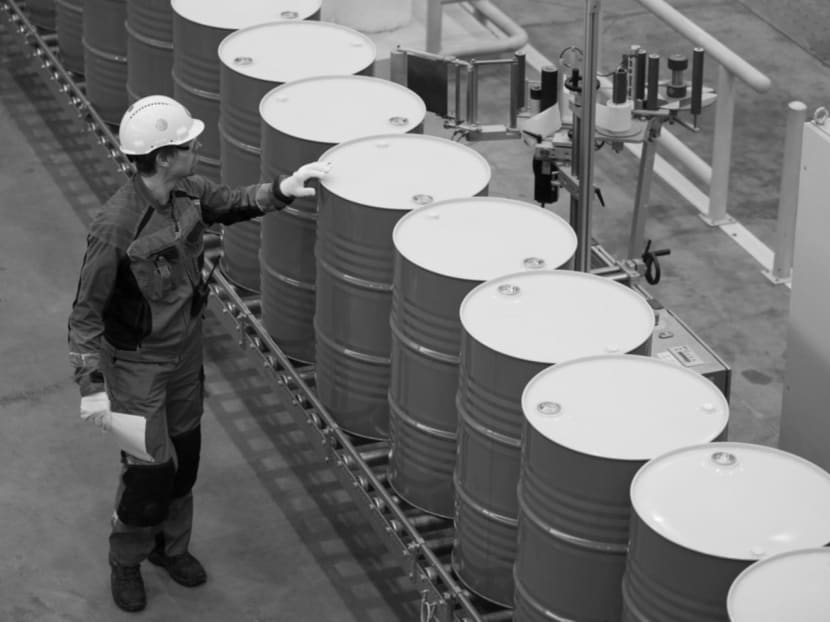Plunging oil prices won’t lead to repeat of 2007 crisis
Last decade, investors learnt a nasty lesson about contagion. When the price of mortgage bonds and related derivatives plunged in the summer of 2007, it initially seemed to be an isolated problem.

An employee checks sealed oil barrels as they move along a conveyor belt after filling at Royal Dutch Shell's lubricants blending plant in Torzhok, Russia. Falling oil prices should have a positive effect on the global economy. Photo: Bloomberg
Last decade, investors learnt a nasty lesson about contagion. When the price of mortgage bonds and related derivatives plunged in the summer of 2007, it initially seemed to be an isolated problem.
Mr Ben Bernanke, then United States Federal Reserve governor, declared that losses on subprime mortgages would be limited to US$25 billion (S$33.1 billion).
But in the event, the panic spread to infect the whole financial system. Losses were 100 times higher.
Could the same thing happen again, as a result of plunging oil prices? This week, Bank of Canada deputy governor Timothy Lane told an energy conference in Wisconsin that central bankers were alert to the possibility that financial links could transmit stress from oil markets to the financial system.
Meanwhile, big investors are pondering those parallels with subprime. Mr Chris Flanagan, head of securitisation at Bank of America Merrill Lynch, recently compared the trajectory of the Brent crude oil price to the ABX index of subprime mortgage derivatives in 2007. He found that the patterns were almost identical.
“As mortgage analysts, our concern with the ‘disorderly’ downside scenario (to oil prices) perhaps is heightened by our experience with the subprime crisis,” he wrote. “We feel that we may have seen this movie before.”
Perhaps so. Whenever one asset class goes into free fall, institutions are forced to sell other assets to meet margin calls, amid a climate of mistrust. These distressed sales are part of the reason for the recent commodity price slump; the levels of volatility in recent days suggest that someone, somewhere in the financial system, is furtively in pain.
NO WIDESPREAD FINANCIAL CONTAGION
But there are at least three reasons to think this year’s thriller will not be as frightening as the 2007 movie, of which it is a sequel.
The first is that falling oil prices should have a positive effect on the global economy. That is radically different from a situation where house prices are falling, creating a recessionary mindset.
Second, and equally important, regulators and investors are anything but complacent. Back in 2007, it was widely believed that the financial system was so healthy that it did not require more capital. This time, regulators have forced financial institutions to build up bigger buffers and these institutions are stress-testing anything that moves.
This week, to name but one example, the big Canadian banks revealed that they were doing stress tests to see what happened if oil fell to US$35 a barrel — even lower than today. Some of the lessons from the subprime saga have been learnt.
There is a third difference, too: The dispersion of infected assets. Back in 2007, losses on mortgage-related assets created a chain reaction because these bonds and derivatives were spread across the system. Not only were they scattered across the portfolios of many investors; they were also used as collateral to underpin trillions of dollars of financial deals.
There is no denying that bonds and derivatives whose value is linked to the oil price make up a noticeable chunk of the financial universe. They account for about one-sixth of risky US corporate debt and sit inside many investor portfolios. But, unlike 2007, they are not widely used to underpin other financial deals.
Furthermore, whereas the banks that got into trouble in 2007 were the bedrock of the entire financial system, energy companies and commodity trading houses are not.
True, if oil companies start defaulting on their bonds, the effects will ripple through the financial system. But they will not make waves. (In any case, most US energy bonds do not even need to be refinanced for another couple of years.)
There are two important caveats. The potential for chain reactions could become more severe if there is serious instability in countries such as Russia.
The pattern could also become more pernicious if it turns out that there are big financial interconnections that regulators cannot see. This scenario cannot be ruled out, given that these two corners of the financial system are murky.
There is limited public data, for example, about what is happening inside the gigantic trading houses or how they are entwined with investment banks. One lesson from recent months is that regulators urgently need to address that.
Still, as a threat to financial stability, the falling oil price is not yet on a par with subprime bonds. Some investors certainly face losses. More volatility lies ahead. The oil price may well fall further. But this is still a story about pockets of pain, not widespread financial contagion.
And that is something we should be grateful for. Particularly given that the global economy still seems sluggish, at best. THE FINANCIAL TIMES
ABOUT THE AUTHOR:
Gillian Tett is the US managing editor at the Financial Times. She writes weekly columns, covering a range of economic, financial, political and social issues.






